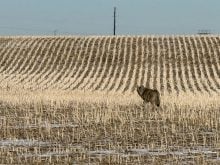Western Canadian winter wheat production will rise to about 700,000 acres in 2004 as more producers use it to solve problems related to profitability and workload timing.
Markets for the fall-seeded cereal have been expanding along with Canadian Wheat Board initiatives to peddle improved varieties to foreign millers.
The varieties have been entering the production chain under the board’s market development contracts, with a new one announced for Aug. 3.
As well, the ability to contract to livestock producers has given growers cash delivery options, said Bob Linnell of Winter Cereals Canada in Weyburn, Sask.
Read Also

Agritechnica Day 2: The future of tractor power, building quicker crop apps and large farms and tech
Agritechnica Day 2: The future of tractor power, building quicker crop apps with Syngenta and large farms and tech
Jim Bessel of the Canola Council of Canada said winter wheat’s popularity among canola producers isn’t just about crop rotations.
“Early fall season cash flow can be an important part of many operations these days,” he said.
The newer varieties also come with better yields and improved disease resistance.
In heavier clay soil and in the eastern Prairies, CDC Buteo is providing good average yields when compared with CDC Kestrel, but it outperforms the popular Kestrel when it comes to leaf and stem rust.
Osprey also performs well in these regions, but disease resistance isn’t as high. It overwinters better than many varieties, however, as does AC Readymade.
Where disease is a problem, the new Manitoba-developed McClintock variety shines with slightly lower yields under dryland conditions, but has very good resistance to stem and leaf rust. It is also reported to produce well under irrigation.
CDC Falcon continues to be popular under southern Alberta irrigation because of high yields, very good resistance to lodging, stem rust and leaf rust and its preference for milder Alberta winters with good snow cover.
AC Bellatrix has proven to yield well under dryland conditions in milder climates such as the Lethbridge area and is resistant to bunt.
Radiant has resistance to leaf curl mite, the carrier of wheat streak mosaic virus, making it a good choice when growing winter wheat on spring wheat stubble. However, it is not designed for heavily rust-prone regions. The variety has just been released and supplies are limited.
To ensure good fall weed control and to prevent curl mites, Linnell recommended a full rate glyphosate burnoff, although producers could go as high as 1.2 litres per acre. This should then be followed by one week “of no-green (growth) barrier between the last crop or fallow period.”
Stem rust can be a problem for non-resistant varieties because it overwinters in Mexico and the southern United States, with spores travelling north on winds.
Winter wheat leaves tend to be generally resistant because of their advanced development by mid-July when the spores arrive in Western Canada.
Brian Fowler, a senior winter wheat breeder with the University of Saskatchewan’s Crop Development Centre, said this is one of the reasons why it’s important to seed the crop as early as possible in the fall.
Land that wasn’t seeded this spring can still be planted this fall if producers chemical fallow their fields and leave significant weed and stubble heights to catch snow.
Bessel said fall-seeded crops free up equipment early in the season.
“Having your cereals in the ground already means you can get the yield advantage from seeding the others earlier.”
Linnell agreed, saying the earlier harvest dates in late July allow producers to spread their harvest labour and equipment over additional days.














